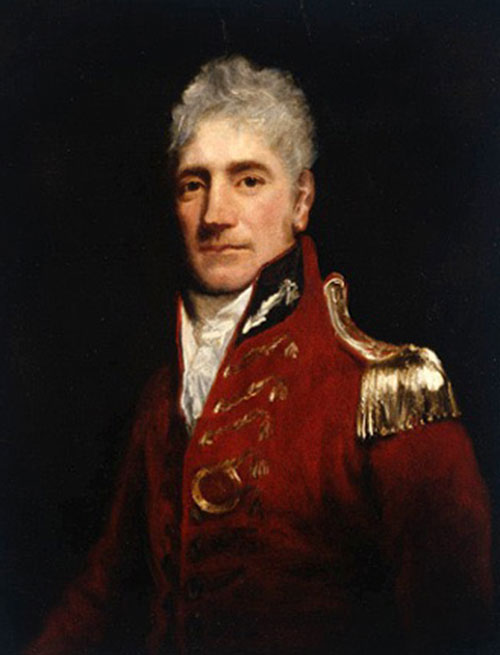Lachlan Macquarie was appointed the fifth and last autocratic Governor of New South Wales on 1 January 1810 – 1 December 1821.
Previous governors struggled to control the New South Wales Corps. Macquarie’s role was to stabilise the colony by re-establishing law and order. Immediately after he arrived, Macquarie replaced the Corps with an army regiment and redirected convict labour away from private assignments back to government work tasks. He regained control over government stores and provided opportunities for emancipists by employing them for administration positions. Macquarie personally appointed all civil officials. Members of the Corps were sent back to England. Macquarie soon found himself battling another group, known as ‘The Exclusives’, consisting of wealthy free settlers, who were often ex-members of the Corps, including John Macarthur.
Macquarie embarked on ambitious public works program, engaging the skills of an emancipist who was sent to the colony for forgery, Francis Greenway. Together, they built churches, schools, and court houses. Greenway’s influence can be seen today in Sydney’s building architecture, such as the Conservatorium of Music (formerly the Governor’s Stables), State Parliament House (the Rum Hospital), St Andrew’s Cathedral, Hyde Park Barracks, and even the lighthouse at South Head. Many of the colony’s most impressive buildings are located along Macquarie Street, Sydney.
Macquarie cleaned up existing areas by naming and straightening main roads and by the end of his governorship, the colony had gained around two hundred main buildings and construction of 480 kilometres of road.
The Bank of New South Wales was established and official currency was introduced in 1817 to stabilise all financial trade, eliminating any influence left from trading rum. A post office was commissioned, and standard weights and measurements were introduced.
Macquarie was ultimately brought down by the Exclusives who constantly challenged his reforms and issued complaints to the British Government, which was also unhappy with him for spending government money on ‘lavish’ public works.
An English judge, John Bigge was appointed to examine Macquarie’s administration. His final report was damning and criticised many reforms that Macquarie had implemented. Bigge supported the wealthy settler’s claims and this caused Macquarie to resign. He returned to Scotland, exhausted and worn out. He died in 1824, while in London defending his actions against John Bigge.
Macquarie crucially influenced the transition of New South Wales from a penal colony towards becoming a free and ordered settlement.
Whilst the Bigge Inquiry failed to understand the challenges of managing the colony, its recommendation to set up a legislative body to administer colonial affairs was the first step towards placing power in the hands of the people. In 1824, the New South Wales Legislative Council was formed to advise the governor of the peoples’ interests in the colony’s development.
See the other resources on the First Five Governors
– Arthur Phillip
– John Hunter
– Philip Gidley King
– William Bligh
– Lachlan Macquarie
Lachlan Macquarie was a Royal Army Officer, reaching the rank of MajorGeneral
Macquarie was born 1761 on the tiny island of Ulva in the Scottish Hebrides
In 1814, the Second Charter of Justice established the Governor’s Court, the Lieutenant-Governor’s Court, and the Supreme Court
Macquarie cleaned the freshwater supply up by forbidding people to wash their clothes in the Tank Stream.
Macquarie was the first to order all traffic on the roads to keep left
When Macquarie established and named Hyde Park, the farmers who grazed their pigs there were most annoyed.
Places named in honour of Governor Macquarie include:
- Port Macquarie
- Macquarie River
- Macquarie Pass
- Macquarie Island
- Macquarie Place
- Macquarie Fields
- Macquarie Lighthouse
- Macquarie Street, Sydney


